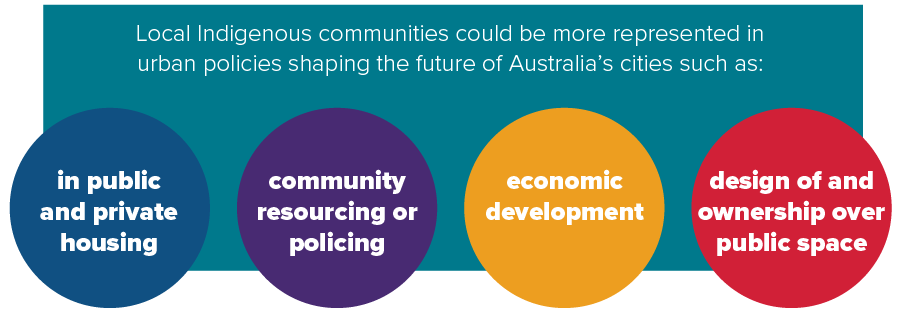In-depth considerations of Indigenous perspectives are notably absent in Australian urban policies beyond acknowledging the traditional owners of the land. The Federal Government’s flagship Smart Cities Plan does not mention the term Indigenous or Aboriginal throughout the entire document. State-level metropolitan planning strategies references to the local Indigenous community are mostly limited to an acknowledgement of country and heritage of Indigenous culture with the need to protect sites and landscapes of cultural significance.
Australia’s cities are Indigenous places. European colonisers of Australia constructed their settlements on sites inhabited by Indigenous people. Australia’s cities remain not only sacred cultural sites, but are also home to many Indigenous Australians. In 2016, almost 80 per cent of Aboriginal and/or Torres Strait Island people lived in an urban area, and around 35 per cent in one of Australia’s capital cities, with over 70,000 people residing in Sydney.

Urban policies would benefit from a closer coordination with other policy frameworks, such as contributing to the success of the Closing the Gap agenda that postulates a shared commitment to empower Aboriginal and Torres Strait Islander people to live healthy and prosperous lives based on local partnerships. Internationally, urban policies are subject to article 26 of the UN Declaration on the Rights of Indigenous People stating that ‘Indigenous peoples have the right to the lands, territories and resources which they have traditionally owned, occupied or otherwise used or acquired'.
Indigenous people are integral to shaping Australia’s cities as traditional custodians of the land, urban residents and land-owners influencing land use and management outcomes. A more comprehensive recognition and representation of Indigenous perspectives would benefit urban policies by informing sustainable practices in shaping the environment, reducing socio-spatial disadvantage and strengthening the cultural heritage of Australia’s cities. Examples include guiding built environment projects by ‘Designing with Country’ to draw on cultural knowledge to deepen the connection to Country and ultimately create better places.
This Brief on ‘Indigenous perspectives’ addresses the way metropolitan planning strategies and reports by the infrastructure bodies consider Indigenous Australians and calls for a more nuanced integration of Indigenous perspectives in urban policies.
Indigenous people are integral to shaping Australia’s cities as traditional custodians of the land, urban residents and land-owners influencing land use and management outcomes.
Conservation and representation of cultural heritage
The metropolitan planning strategies in New South Wales, Queensland and Victoria emphasise the relation of Indigenous communities to Australia’s cities, acknowledging the traditional land on which the nation’s settlements were built and the need to reflect this legacy in the naming of places. The Greater Sydney Region Plan: A Metropolis of Three Cities divides the Sydney metropolitan area into three cities reflecting Indigenous relationship with the land: ‘saltwater country’ (the Eastern Harbour City), ‘muddy river country’ (the Central River City) and ‘running water country’ (the Western Parkland City). Urban policies explore the role of Indigenous Land Councils as landowners. However, cultural uses of land on the urban fringe owned by Indigenous Land Councils are often balanced against economic interests.
Beyond the conservation of cultural heritage, local Indigenous communities could be more represented in urban policies shaping the future of Australia’s cities. This could entail more involvement of Indigenous communities in urban planning processes, such as in public and private housing, community resourcing or policing, economic development, design of and ownership over public space.

Community consultation
Some metropolitan planning strategies refer to their consultations with local Indigenous communities to develop their vision. Shaping SEQ provides a map on sustaining Indigenous landscape values that have cultural, spiritual and environmental significance. By recognising Indigenous rights and interests, the strategy claims to integrate Indigenous perspectives in land use planning and represent Indigenous people in preparing the plans. The Greater Sydney Region Plan: A Metropolis of Three Cities refers to the economic and cultural role of contemporary Indigenous communities in their contribution to creative industries and by supporting small Indigenous businesses and employment. Similarly, Plan Melbourne 2017-2050 tries to embed Indigenous perspectives in planning, design and natural resource management through ongoing partnerships. Yet, the depth and objectives of engagement differ considerably between state-level urban policies and would benefit from more specific implementation mechanisms.
Social disadvantage
Indigenous people remain amongst the most socially disadvantaged cohorts in Australia. Strategies to improve Indigenous livelihoods in urban policies mostly refer to remote Indigenous communities and emphasise the need to develop remote areas and provide better access and services. Infrastructure Australia aims to help Indigenous communities to become more sustainable and resilient, improving remote infrastructure, such as installing renewable energy sources, and building on local expertise. The Northern Territory 10 Year Infrastructure Plan 2018-2027 references the need to support Indigenous cultural businesses in developing sustainable commercial opportunities and to invest in social infrastructure, such as in educational, cultural, community and health infrastructure.
Yet, urban policies refer less to social disadvantage experienced by Indigenous communities in urban locations. AHURI evidence highlights that reliance on social housing among Indigenous households is high and increasing. More diverse housing choices and better culturally adapted services could be provided through an intercultural approach in partnership with Indigenous organisations.
More diverse housing choices and better culturally adapted services could be provided through an intercultural approach in partnership with Indigenous organisations.

